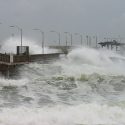Scientists share in Great Lakes project
Two university scientists will contribute to a $6 million research project of the U.S. Environmental Protection Agency that will take a comprehensive look at the environmental health of coastal and near-shore regions of the Great Lakes.
The landmark project will be directed by the Natural Resources Research Institute of the University of Minnesota Duluth and is part of the EPA’s Science to Achieve Results research program.
Headed by NRRI center director and professor Gerald Niemi, the goal will be to identify, evaluate and recommend a portfolio of environmental indicators to measure the condition of the Great Lakes. The assessment tools will help maintain the integrity and long-term sustainability of the lakes.
Like medical doctors who start with vital signs and then move on to specific diagnostic tests, a team of 27 experts will closely examine the health of the Great Lakes.
Participating from UW–Madison will be David Mladenoff, an associate professor of forest ecology and management; and Joy Zedler, professor of botanyand Aldo Leopold Chair of Restoration Ecology. Mladenoff’s research expertise focuses on the relationships between human land use and natural processes, while Zedler studies wetland ecology.
Mladenoff will apply geographic information system, or GIS, tools and techniques to help determine larger-scale threats to the watershed, its biota, and ecological functions due to land use changes. His research team uses GIS to quantify the patterns in the landscape and how they relate to several ecological processes. These measures may also be related to water quality, by revealing the nature of runoff, erosion, contaminant movement into the streams and lakes and filtering capacity of wetlands.
Zedler will develop a way to measure the health of coastal wetlands vegetation in relation to various environmental stressors, such as changes in water levels, modifications in land, chemical changes from pollution and invasive species. She will work on Lake Michigan coastal wetland regions, while other scientists provide data on Lake Ontario and Lake Superior wetlands. Botany doctoral student Christin Frieswyk has been brought on board for the project.
Other participating universities include UW-Green Bay, UM Twin Cities, Minnesota Sea Grant, Cornell University, University of Windsor-Canada, John Carroll University and the University of Michigan. Scientists from the U.S. EPA Mid-Continent Ecology Division in Duluth and research station in Grosse Ile, Michigan, are also involved.
Environmental indicators are biological, chemical or physical attributes of an ecosystem that can be measured and monitored to provide insight on the study area’s condition. Indicators provide an early warning system of potential problems and a proactive approach to integrating ecosystem management with increasing human needs.
Study sites for this massive project will span the 200,000-square-mile basin. Research will be broken into five major components: water quality and microscopic algae; fish and aquatic insects; wetland vegetation; birds and amphibians; and chemical contaminants.
The Great Lakes basin, which spans two countries including eight states and one province, contains approximately 18 percent of the world’s surface fresh water. What happens in one section has ripple effects across the entire basin and affects more than 36 million residents. For more information on this project, contact Brenda Maas, (218) 720-4300.


